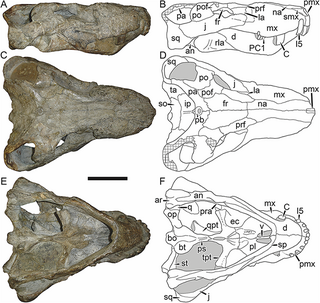| Nitosaurus | |
|---|---|
| Scientific classification | |
| Domain: | Eukaryota |
| Kingdom: | Animalia |
| Phylum: | Chordata |
| Clade: | Synapsida |
| Family: | † Nitosauridae |
| Genus: | † Nitosaurus Romer, 1937 |
| Nitosaurus | |
|---|---|
| Scientific classification | |
| Domain: | Eukaryota |
| Kingdom: | Animalia |
| Phylum: | Chordata |
| Clade: | Synapsida |
| Family: | † Nitosauridae |
| Genus: | † Nitosaurus Romer, 1937 |

Synapsida is one of the two major clades of vertebrate animals in the group Amniota, the other being the Sauropsida. The synapsids were the dominant land animals in the late Paleozoic and early Mesozoic, but the only group that survived into the Cenozoic are mammals. Unlike other amniotes, synapsids have a single temporal fenestra, an opening low in the skull roof behind each eye orbit, leaving a bony arch beneath each; this accounts for their name. The distinctive temporal fenestra developed about 318 million years ago during the Late Carboniferous period, when synapsids and sauropsids diverged, but was subsequently merged with the orbit in early mammals.
Calleonasus is an extinct genus of non-mammalian synapsid from the Anisian Donguz Formation of Russia.
Colobodectes is an extinct genus of dicynodont therapsid from the Tapinocephalus Assemblage Zone in the Abrahamskraal Formation, South Africa.
Cistecephaloides is an extinct genus of dicynodont therapsids of the Cistecephalus Assemblage Zone, Beaufort Group of South Africa.
Driveria is an extinct genus of non-mammalian synapsids the Lower Permian of San Angelo Formation, Texas. It is mostly known from several postcranial bones, including the scapula, pelvis, and a few vertebrae and ribs, although a fragment of the skull that might pertain to the upper temporal fenestra is also associated with this species.
Elatosaurus is an extinct genus of non-mammalian synapsid.
Emydorhinus is an extinct genus of non-mammalian synapsid.
Ictidostoma is an extinct genus of non-mammalian synapsids known from the Tropidostoma Assemblage Zone.
Lanthanostegus is an extinct genus of non-mammalian synapsids from the Capitanian Tapinocephalus Assemblage Zone, Koonap Formation of South Africa. The type and the only species is Lanthanostegus mohoii.
Mastersonia is an extinct genus of non-mammalian therapsids from the Lower Permian of San Angelo Formation, Texas. It is only known from a few, very large vertebrae.

Milosaurus is an extinct genus of non-mammalian synapsids native to Illinois that was alive during the latest Carboniferous and earliest Permian. It was named in 1970 on the basis of FMNH 701, a partial skeleton, as well as referred material.
Microsyodon is an extinct genus of non-mammalian therapsids.
Orthopus is an extinct genus of non-mammalian synapsids. It is based on a partial humerus that closely resembles Estemmenosuchus, in the limited comparisons possible.
Palemydops is an extinct genus of non-mammalian synapsid.
Scalopolacerta is an extinct genus of non-mammalian synapsids.
Trichasaurus is an extinct genus of caseid synapsids.

Stereophallodon is an extinct genus of non-mammalian synapsids.

Xyrospondylus is an extinct genus of non-mammalian synapsids belonging to the Edaphosauridae. The type species, X. ecordi, was named in 1982; it was originally named as a species of Edaphosaurus in 1957.

Watongia is an extinct genus of non-mammalian synapsids from Middle Permian of Oklahoma. Only one species has been described, Watongia meieri, from the Chickasha Formation. It was assigned to family Gorgonopsidae by Olson and to Eotitanosuchia by Carroll. Reisz and collaborators assigned the genus in Varanopidae. Based on comparisons of its vertebrae with other varanopids, it was the largest varanopid with a body length of approximately 2 metres. It was a contemporary of its closest relative, the much smaller Varanodon; the two may possibly represent growth stages of a single animal.

Leontosaurus is an extinct genus of non-mammalian synapsids from the Dicynodon Assemblage Zone, Balfour Formation of South Africa. It contains the single species L. vanderhorsti.